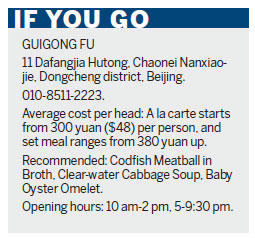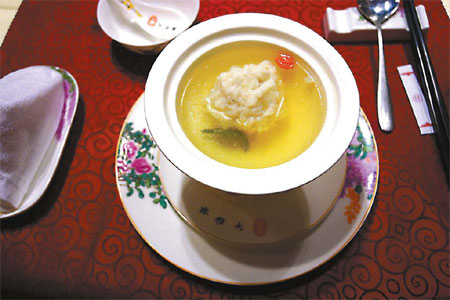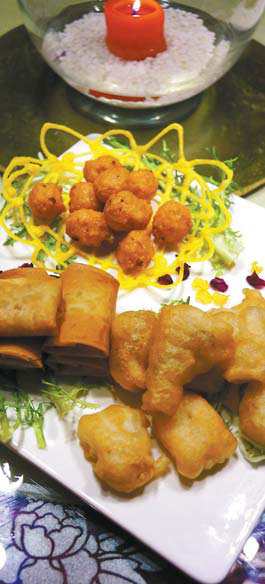Going home to Ci Xi
Updated: 2012-10-13 08:10
By Ye Jun (China Daily)
|
|||||||||||
|
Codfish meatball used to please Empress Ci Xi and is now recommended on Guigong Fu's menu. Photos by Ye Jun / China Daily |
|
Diners can have a try at the combo plate of deep-fried mashed shrimp balls, fish wrapped with flour and spring rolls. |
This is the house where the Empress Dowager lived as a girl before she married into the Forbidden Palace. But now it is home to just memories and fine cuisine, as Ye Jun discovers.
Beijing has numerous restaurants housed in the traditional Chinese courtyard homes, but Guigong Fu is probably one of the biggest of its kind. It is said to be the only existing courtyard house where a Qing Dynasty (1644-1911) empress had once lived.
Beijing's courtyard houses share many similarities: They are usually serene and comfortable. They are beautifully built, with grey tiles, huge columns in dark red paint, and colorful motifs of bird, flower or scenery on the eaves.
 |
This is especially so at Guigong Fu, Duke Gui's Residence. The former owner, Duke Guixiang, was the second brother of the powerful Qing Dynasty Empress Ci Xi, often depicted in Chinese films as a cruel, bad-tempered, powerful old woman controlling the emperors.
It is recorded that the only time Ci Xi came back to visit her mother's family was to Guigong Fu. Moreover, Duke Guixiang's daughter was married to Qing Dynasty Emperor Guangxu. For that reason, Guigong Fu used to be called "phoenix nest", a reference to the queen being the phoenix in relation to the emperor being the dragon.
Today the once royal home is hidden among residential buildings in the winding hutong near Nanxiaojie, with its ownership having changed hands several times in the past years.
It was first a restaurant offering dishes made with tea, then it became a roast duck restaurant.
Now, an experienced businessman from Shantou in Guangdong province has just taken over, and plans to promote a main menu of imperial cuisine based on historical research, with satellite offerings from the Chaozhou and Shantou in Guangdong.
There are many stories, and waitresses clad in colorful Qing Dynasty costume will patiently explain how a pork meatball was adapted using fish to please the empress Ci Xi, and served in a porcelain platter beautifully decorated with flowers.
The meatball is made with tender cod and crunchy diced water chestnut, bathed in a broth made of ham and chicken.
"Clear-water cabbage" is another traditional dish from the royal kitchens. The soup looks clear, but has actually undergone a complicated filtering process to clarify the intensely tasty chicken broth.
At Guigong Fu, it is not just the imperial dishes that appeal, the commoners' favorites from Chaozhou and Shantou are also eye-openers.
Snow-white squid is freshly scalded, cut into rings, and served with two sauces to dip into. One is a soy-bean sauce, another a very good home-made chili sauce that has penetrating strength, which helps to whet the appetite.
Small oysters are mixed into egg and deep-fried to make an omelet. It also goes well with the sauces.
Pu'ning in Guangdong is famous for its bean curd made with potato powder and soya bean. It is most commonly served deep-fried, to offer a crisp skin and tender insides.
Deep-fried mashed shrimp balls, fish wrapped with flour and spring rolls are a combo plate worth trying. Finish with a very delectable plate of jiaozi with pork stuffing and bits of black fungus and carrot.
The furniture is traditional Chinese style, and paintings and calligraphy works hang on the walls. In the evening, there are Chinese instrumental performances, including the guqin, a very relaxed and soothing style of music.
The owner of the restaurant is a big fan of Chinese teas and the restaurant offers almost every style of Chinese tea. The peaceful courtyard environment is an ideal place to sip a cup of tea and enjoy some leisure time before or after a meal.
Contact the writer atyejun@chinadaily.com.cn.
(China Daily 10/13/2012 page12)
Today's Top News
Rescuers race against time for quake victims
Telecom workers restore links
Coal mine blast kills 18 in Jilin
Intl scholarship puts China on the map
More bird flu patients discharged
Gold loses sheen, but still a safe bet
US 'turns blind eye to human rights'
Telecom workers restore links
Hot Topics
Lunar probe , China growth forecasts, Emission rules get tougher, China seen through 'colored lens', International board,
Editor's Picks

|

|

|

|

|

|







